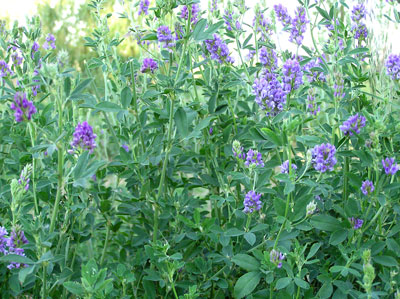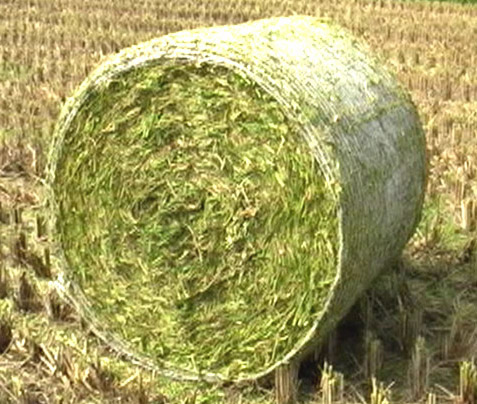No matter what types of silage, roughage, concentrate and other feeds are used, dairy cows always need a minimum amount of fibre. Fibre is essential for the functions of the rumen, and a well-functioning rumen is the basis of a healthy, well-producing dairy cow. In a daily feed portion, 25-27 % of the dry matter should come from NDF-fibre in the roughage. Fibre not only affects the layering inside the rumen, but also increases ruminating and the amount of saliva excreted. Saliva keeps the pH of the rumen steady, and prevents acidosis.
Not all types of NDF-fibre are as effective. The particle size should be over 3 mm, but increasing the size over 6-10 mm doesn't increase ruminating any further. Fibre from roughage is more efficient than fibre in concentrate, mostly due to the difference in particle size. However, roughage with a high D-value can be low in fibre.Composition of the roughage is also important: legumes have less fibre than hay plants, and their NDF has a lower digestibility, even though the D-value is similar. Legumes and corn have about 150 g less NDF in a 1 kilogram of dry matter.
Crude protein
Dairy cows should get 130-140 g / 1 kg DM of crude protein (CP) daily. CP content higher than 140 g/kg DM is not utilized effectively, and increases N excreted in faeces. Studies show that cattle utilizes 0 % of the nitrogen, when it added by using fertilizers high in N. In contrast, cows utilise 16 % of nitrogen in silage harvested early. Succesful fermentation and high D-value increase the CP value.
D-value
D-value describes the digestible portion of the organic content of the feed. Target D-value in hay-based feed is 650-690 (65-69 %). The earlier the silage is harvested, the higher the D-value is. When the D-value of a feed is high, adding concentrate increases milk yield only slightly. On the other hand, the impacts of poor D-value can only partially be covered by adding concentrate. Low D-value leads to low amounts of feed eaten, which lowers the CP, fibre and other nutrients received.
From the start of June, the D-value of hay in the first harvest decreases 0,5 % a day due to lignification.In the 2nd and 3rd harvests the decrease is much slower, but the feed values and amount of digestible fibre of late harvests are lower anyway.
Feed ingredients
RyegrassesItalian ryegrass as more leaves and is more palatable than Westerwold ryegrass. The D-value of the Italian variety also decreases slower, but the plant grows more slowly and has more weeds in the 1st harvest than the Westerwold species. Westerwold is thus considered a better fir for fermented silage.
 |
| (c) www.herrinhs.org |
Red clover has a high amount of crude protein and is highly palatable, but may be difficult to store by fermentation. Is has less fibre than hay. Due to the high palatability animals eat red clover more than grass-based silage even though the clover had a lower D-value and less fibre. Red clover feed increases milk yield and the amount of unsaturated fats in the milk. It is recommended to be used together with grass- or hay-based silage. Note that red clovers are high in potassium, so grazing animals on pastures with plenty of red clover may lead to grass staggers.
 |
| (c) www.innerpath.com.au |
The queen of crops, lucerne is the most important silage ingredient in the world. It is used as silage, dried and as pastures. Lucerne is very high in crude protein, so it should be mixed with hay or grass to bring the CP down to a reasonable level. Lucerne also has lower fibre content and lower digestibility than hay, which are compensated by higher palatability. Compared to red clover, lucerne affects milk yield as well as or even better than red clover.
Straw
The gross energy of straw is high, but due to extremely low digestibility it yields practically no energy to the cow. Straw in a whole crop silage has more energy and higher digestibility than that of a fully ripened crops. It is mostly used to increase the fibre content especially for dry cows and heifers. Straw is also very good for beed cattle fed with high amounts of concentrate, and for suckler cows. Straw is not necessary for cattle fed with hay- or grass-based silage.
 |
| whole crop silage (c) takakita-net.co.jp |
Wheat and barley are the most used species, because they have the highest palatability. Oat has a lower digestibility, and is used mostly for dry cows and heifers. Rye is palatable only if harvested early, but even then it is usually too expensive to be used for cattle feed. Whole crop silage can be used alone or together with grass- or hay-silage to offset the high crude protein content of the silage.
Harvesting of whole crop silage must be considered carefully. If it is harvested too early, the feed has low dry matter content and low digestibility, and may be difficult to preserve by fermentation. Late harvesting causes losses due to shedding, and the feed does not ferment. In addition to harvesting, the crops used and their properties impact the quality of whole crop silage.
 |
| Peas. (c) TerraLink |
Peas have plenty of crude protein, and are best used in together with whole crop silage. Growing pea together with grains reduces the need for nitrogenous fertilizers and increases the protein content and digestibility of the silage. However, shedding losses may be noticeable, and peas are difficult to preserve by fermentation. Peas are annual plants and the seeds may be expensive, but if the harvesting is done well, the yield is high.
 |
| (c) Suomen Rehu |
Concentrate is used to increase the amount of one or more nutrient in the feed mix. Energy feeds and protein feeds are the most common ones used, but minerals and vitamins are also often part of concentrates. The impact of increased protein and energy on milk yield is limited, and can be minimal if the D-value of roughage is high. Too high amounts of concentrate reduce the amount og roughage eated, which again reduces the amount of fibre gained, and leads to bloat and acidosis. A commercial "full concentrate" has no grains, and contains usually 30-45 % CP and 10-11 ME MJ. A "semi-concentrate", which includes grains, has 23-30 % CP and 12-13 ME MJ.
More information
Dairy animal nutrition by Penn State UniversityOther posts in this blog about animal nutrition:
Feeding beef cattle
Feeding poulty
Legumes, rapeseed and grains in pig production
Determining feed digestibility
Value, quality and preservation of silage

It is very important to feed the right kind of feed to the dairy animals because the production of milk and meat depends on a good feed. All this information is very useful for the farmers.
ReplyDeleteNice Blog. Thanks for Sharing. JS Pelleting Technologies is a Cattle Feed plant manufacturer and supplier in Punjab, India.
ReplyDelete
ReplyDeleteAll the information is satisfactory. feeding good quality silage to cattle has various benefits which help them work better, take care of the farm and increase he farm profits.
Las Vegas casino - JT Hub
ReplyDeleteI will never go back to Las Vegas again and find 순천 출장마사지 an alternative hotel. This is 제주도 출장마사지 the best resort in Las Vegas. 평택 출장안마 The hotel 동해 출장마사지 is located just a 5-minute drive 수원 출장마사지 from the Las